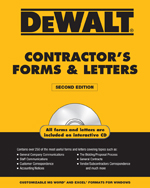
How much to charge for your services is the focal point of any trade business. Charge too much and you won’t get the job, charge too little and you’ll go broke. Then you have to face the facts that every job is different, estimating is an inexact science and customers always can get a bid that’s cheaper if they shop around. Many customers subscribe to the old wives’ tale that they are best served by getting three quotes and taking the one in the middle. In most cases the top bidder is likely to be the only one of the bunch who has built enough into his quote to make a profit.
Consequently, price resistance is a daily occurrence for people in your business. There is a huge temptation to lower your price in order to get the work, but in the long run that’s a path to bankruptcy. Instead, it’s essential to convince the customer that the price you quote is fair and of better value than the customer can get from competitors offering a lower price.
Top sales professionals will tell you that every price objection amounts to a failure to sufficiently sell your value. That’s true as far as it goes, but what you need to focus on are some specific strategies to help you hold the line on what you need to charge in order to prosper. Here are some tips that I’ve picked up over the years from various successful trade contractors.
• Professionalism counts: You’ll always have a strong case for a higher price if you convey a better impression than competitors. This means no “ballpark figure” quotes on hand-scrawled pieces of paper. Would you buy a new rig from a dealer whose paperwork amounted to a legal pad and barely legible handwriting? Well, many of your jobs cost even more than a rig. Use preprinted business forms to record measurements, data and notes. Put it inside a presentation folder that includes technical literature, a company brochure, copies of your license and insurance information, product cut sheets and anything else the customer might find useful. Especially, include testimonials from satisfied customers. Throw in some notepads, refrigerator magnets and some other promo items with your logo and contact information. Professionalism also means making an appointment for the bid presentation and–especially–showing up on time, dressed in a presentable manner. This doesn’t necessarily mean wearing a suit and tie. It does mean changing out of soiled work clothes. A monogrammed shirt with your company insignia would be fine.
• Sell your expertise: Draw attention to special qualifications you or anyone else in your company may have. These could include academic credentials and certifications, trade association leadership positions, articles written about you or your company, articles you may have written for trade magazines and so on. Think of everything you’ve accomplished that even remotely relates to your business, and lay it on the line. Add up the combined years of experience of everyone in your company, so you can say, “We’ve been doing this for more than a half century …” or whatever the timeline might be.
• Make sure all buyer influences are present: With married couples, make sure both parties are present during your presentation. A husband might think he’s the one making the decision, but if the wife expresses dismay at your bid, your hard work in selling the job could easily go down the drain. With commercial work, take time to talk to all decision makers. The project manager may be on your side, but the CEO could overrule his recommendation, so try to make a presentation to the CEO as well.
• Make sure comparisons are apples to apples: Where competing bids are involved, ask to see how the competitors’ quotes are presented. Go through them in detail and point out areas where your bid includes things theirs do not. Educate the customer about things to look for regarding scope of work, qualifications to look for in choosing a contractor, why certain products are better than others, and what distinguishes good from poor workmanship. Talk about the potential consequences of things going wrong, and the protections you offer that others may not.
• Don’t disparage competitors: It’s okay to differentiate your bid from theirs and point out things you do that they don’t, but take the high road. Avoid badmouthing competitors. Focus on the positives about your company rather than their negatives. Various studies have shown that people react negatively to negativism. Aim to conduct yourself in a more professional manner than the other bidders.
• Encourage questions: Keep asking would-be customers things like, “Is there anything more you’d like to know about this project ... what more can I tell you that would be helpful … do you have any questions?” This demonstrates concern for them, and also helps to clarify misunderstandings before they arise.
• Sell up by selling down: Top salespeople always sell up by selling down. They know that presenting options in a “best-better-good” order works better than starting “good-better-best.” That’s because consumer psychology is such that people will tend to get fixated on the price of the “good” option and tune out everything that’s more expensive. But if you first entice them by explaining the features and benefits of the best option, they will feel a sense of loss when you explain what they have to give up by going down in price. Nonetheless, if they get sticker shock at your “best” offer, the option still exists for them to scale down to a more comfortable price range.
• Negotiate warranties, schedules, etc.: If the customer proves to be a tough price negotiator, think of things you can give up without much pain instead of lowering your price. Maybe it’s extending the workmanship warranty beyond the standard length, or making some scheduling concession, or extending the payment period.
• Guarantee satisfaction: This takes guts, and you better be really good at what you do, but a “satisfaction guaranteed” sales pitch often does the trick. Use appropriate disclaimers, but simply tell the customer that you’ll assure the job gets done to their complete satisfaction. (Some businesses offer money-back guarantees, but that’s a little too risky with high-volume jobs.) Put it in writing, because verbal guarantees too often get remembered differently by buyer and seller.




Report Abusive Comment